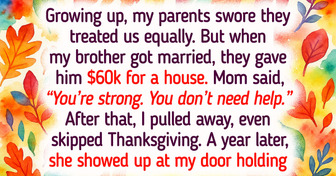12 Times Celebs’ Bodyguards Went Above and Beyond, and We Admire Their Dedication


We never believe that something bad can happen to our children or us, and we often don’t take simple precautions against these situations.
Bright Side will tell you how to prevent dangerous situations in the city and on vacation.
Make it a family habit to call each other when leaving school, work, or home and when arriving at an appointed place. If the children see that even the adults do the same, they will see these calls not as a method of control but as the normal caring of family members for each other.
If your child tells you something that sounds suspicious, even if it concerns your family friends, teachers, etc, trust their words. Be sure to find out all the circumstances of the situation because kidnappers and rapists are often people the child knows.
If your child calls you and asks you to pick them up, do it. Perhaps the child can’t tell you about their suspicions and doubts over the phone.
If your child didn’t come at the appointed time, text and call your relatives and the child’s friends, classmates, and teachers. When your child is missing, every minute is precious, so it’s important to immediately contact those who could see where and with whom the child went. Also, keep current emergency and search and rescue organizations’ phone numbers.
After your child has been found, don’t forget to tell everyone that everything is okay.
If your child goes missing, describing them and their clothes will be more difficult than showing their picture to those who could see your child and sending it to people involved in search and rescue efforts.
Whatever the reason may be for your child going missing, it’s necessary to start searching for them immediately. In the worst case scenario, time will be the factor working against you.
In an emergency, your child may become confused, even if they theoretically know what to do. Get ready in advance. Regularly repeat with them their address and their parents’ phone numbers. Play out different situations: what to do if your child is lost in a store, can’t find their parents on public transportation, or if a stranger tries to take your child away, offers them candy, or asks for help. In a deserted place, practice shouting and calling for help together.
If you go to the forest to pick mushrooms or to the park for a picnic, it could be useful to take photos of your children’s shoe soles. If your child gets lost, the shoeprints will help with search and rescue efforts. Don’t let your child wear camouflage clothing — it should be bright.
If you go to a crowded place (a concert, a mall, a park), always agree on where you’ll meet if you get separated, even if you have a cell phone with you (it may get discharged, lost, etc). It’s better to choose a place that can be spotted from afar: a fountain, the main entrance, and so on.
Banning your child from using social media will only increase their curiosity. Most likely, your child will just use fake pages and false names. Instead, let your child have their own account: you’ll be able to see what they are interested in and who they are friends with.
Teach your child the rules of internet security: how to respond to online advertising, cyberbullying, scam messages, and suspicious adults’ attempts to get to know them.
You can also install a parental control program that blocks dangerous websites and shows what Web resources your child is using.
Install an app on your child’s phone that will track their coordinates and that can give an SOS alert signal. If your child has a push-button phone without internet access, connect to the mobile operator’s service that lets you know the owner’s coordinates.
You can buy a separate GPS tracker in the form of a bracelet or a watch that tracks the location of your child.
Write down your phone numbers as well as your friends’ and relatives’ on a piece of paper in case you can’t be reached, together with medical allergies if your child has them. Let your child always keep this piece of paper in their inside pocket.
When your child is lost, it makes things worse when they are afraid that you will be angry with them for it. Therefore, your child can forget how to act in this situation. When talking with your child about safety rules, be sure to emphasize that you won’t ever scold them.
If your child was lost and then found, comfort them, hug them, look your child in the eyes, and breathe with them. When they calm down, discuss everything together: why this happened and what should be done to prevent this from happening again.
An experiment found that 7 out of 9 children would follow a stranger out of the playground while their parent was distracted.
You can arrange a lecture or training in your child’s group or class concerning how to avoid a dangerous situation and how to act if it did happen.
No one wants to bring up an anxious child who is afraid of their own shadow. Don’t scare your son or daughter, but be consistent in teaching them safety rules because there is nothing more precious than your loved ones’ life and health.











